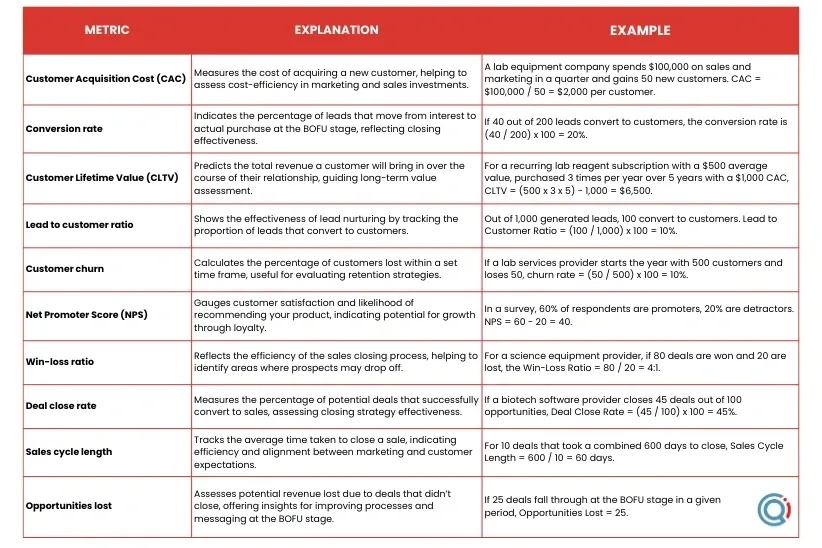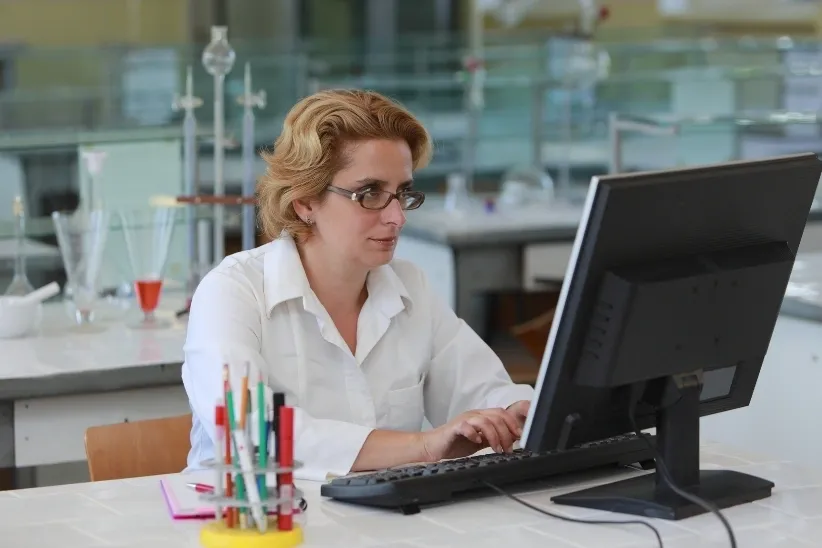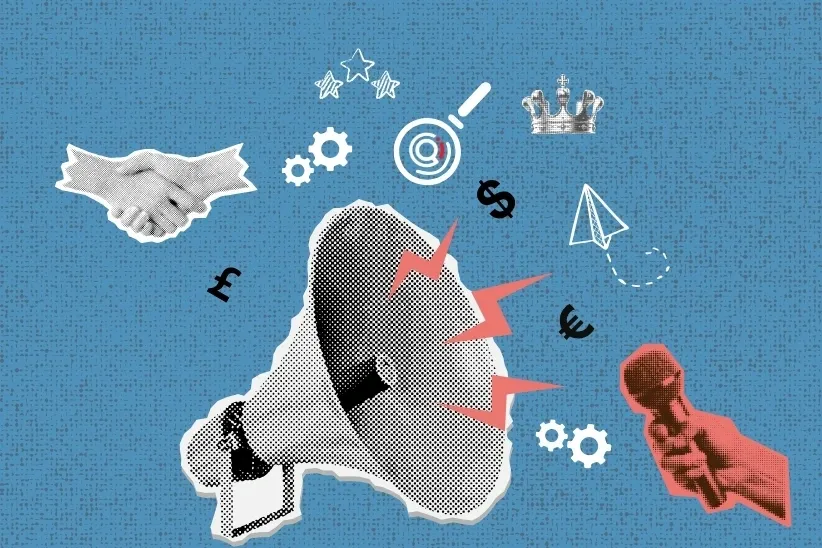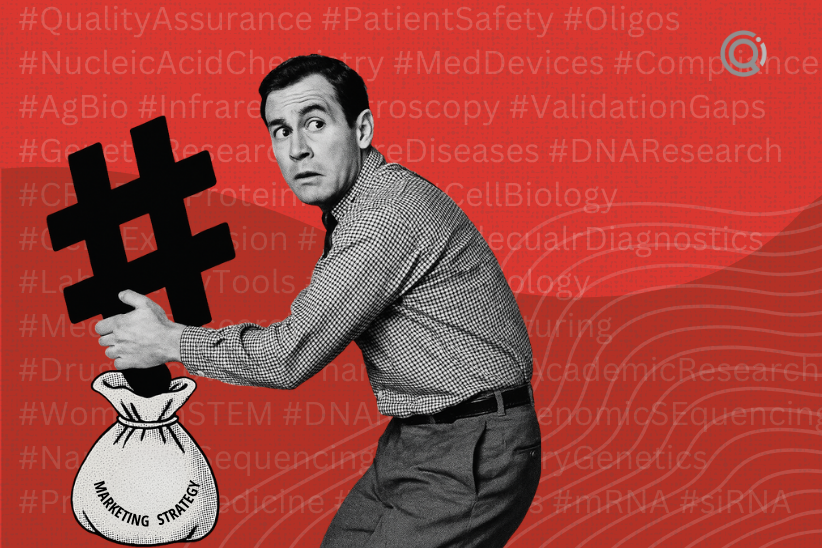It’s not about you
You’ve successfully guided your prospects through the awareness (TOFU) and consideration (MOFU) stages, and now they’re at the most critical point in their buyer’s journey: the decision stage. The goal is to ensure you have installed a bucket at the end of your funnel, to capture those customers rather than let them escape right at the finishing line. The Bottom-of-the-Funnel (BOFU) is where you should see your earlier nurturing efforts paying off. At the BOFU stage, it’s all about delivering that final experience that convinces prospects your solution is their best option.
For science and technology marketers, the stakes are high since the products and services we work with are often complex, require high investment and post-purchase installation or data interpretation support and are often used within highly regulated environments. Complex products require trust, and trust is earned by consistency. This means that your BOFU tactics must focus on removing any final doubts while demonstrating the long-term value of your offering.
“The key to mastering the art of sales is switching statements about you – how great you are, how great your company is – to statements about them.” – Jeffrey Gitomer, Salesperson, author, speaker
This blog explores successful BOFU strategies tailored to science marketers with examples from our sector.

Key metrics for BOFU evaluation
Evaluating BOFU effectiveness requires choosing metrics that actually matter. Each data point below offers specific insights, from cost efficiency to conversions, but tracking all of them is overkill. Sales and marketing must align here — prioritizing metrics that drive real revenue impact. Select key metrics, assign ownership, and focus on what truly moves the needle.
- Customer Acquisition Cost (CAC): The cost-efficiency of acquiring customers that can help guide resource allocation to improve profitability.
- Conversion rate: The percentage of leads at the BOFU stage that convert both into opportunities and paying customers, providing insight into the effectiveness of your final-stage marketing efforts.
- Customer lifetime value (CLTV): Calculates the total revenue a customer is expected to bring in over the duration of their relationship with you, helping to assess the long-term value of each acquisition.
- Lead to customer ratio: The proportion of leads that progress from initial engagement to becoming customers, indicating the quality and effectiveness of lead nurturing.
- Customer churn: The percentage of customers lost over a specific time period, helping to assess the retention impact of BOFU strategies and post-purchase support.
- Net Promoter Score (NPS): Measures customer satisfaction and likelihood to recommend, providing insights into customer sentiment post-purchase and the potential for loyalty-driven growth.
- Win-Loss ratio: This metric highlights the effectiveness of your closing strategy and helps to identify areas where prospects might be falling out.
- Deal close rate: This metric is fundamental for understanding the efficiency of your sales process. A higher close rate indicates that your BOFU strategies are working well to convert interested prospects into customers.
- Sales cycle length: Reducing the time it takes to close a deal is particularly important. A shorter sales cycle can signal that your marketing and sales efforts are aligned effectively to meet customer expectations, enabling quicker decision-making.
- Opportunities lost: Understanding why deals fall through at BOFU allows sales and marketing teams to refine their messaging and processes to better serve prospects’ needs.

Effective BOFU tactics for science marketers
The mix of tactics that you’re likely deploy depends heavily upon the kind of financial commitment your would-be customers are considering making. For example, instruments for the lab represent far greater investment compared to reagents that might be required to carry out day-to-day bench work. This will influence the levels of risk aversion of your buyers and should be incorporated into messaging and tactics that you need to plan.
- Tailored product demonstrations that solve specific problems
By the time a prospect reaches the BOFU stage, they’ve already shown strong interest. Now, they need to see exactly how your product solves their specific challenges. Generic demos won’t cut it—what they need is a personalized, solution-driven demonstration or presentation that talks to their exact situation.
For example, if you’re marketing lab automation software for pharmaceutical research, consider inviting the prospect to provide their own experimental workflows and data (post-NDA signing, of course). Then, demonstrate how your software automates repetitive tasks, reduces human error, and speeds up output and analysis. By placing the customer at the centre of your demo, you make it easier for them to envision it working for them.
“People are generally better persuaded by the reasons which they have themselves discovered than by those which have come into the mind of others.” – Blaise Pascal, French mathematician and philosopher
Reducing hesitation the Agilent way
Agilent, a leader in lab technologies, excels in offering tailored product demonstrations. For example, when showcasing their liquid chromatography systems, Agilent provides prospective clients with personalized demos using their own sample types and research conditions. This level of customization helps scientists and lab managers see how the system can streamline their research processes, improve data accuracy, and increase productivity. Such tailored engagement reduces the customer’s hesitation and demonstrates how Agilent’s solutions can solve their unique challenges.

- Risk-free trials and pilot programs
One other way to help your customers overcome hesitation at the BOFU stage is to eliminate the risk via trial and pilot programmes. This allows your customers to test your product in their environment and discuss with internal teams before making a significant financial commitment, which is especially important for high-cost technologies. It is also a great way to appeal to several decision-makers who are typically influential in a purchasing decision in the B2B space. Data from Gartner Research suggests that the primary B2B buying group typically involves between 6–10 decision-makers [1].
Try offering a 30-day trial that gives potential customers and their teams a risk-free opportunity to experience the product.
Personalized support with Thermo Fisher Scientific
The company facilitates opportunities for customers to engage with their equipment through personalized consultations, demonstrations, and potential lab setups, allowing labs to better understand the functionality and advantages of their systems before committing. This includes supporting new labs with discounted products and services. The company also provides services like on-demand maintenance, installation, and compliance support to help labs ensure optimal functionality.
By offering trials Thermo Fisher reassures its customers with firsthand experiences, increasing confidence in their buying decision.
- Showcasing ROI with calculators and case studies
At the bottom-of-the-funnel data-hungry prospects are looking for hard numbers to justify their investment. A well-crafted ROI calculator, combined with real-world case studies can help offer tangible proof of your product’s value.
Consider building an ROI calculator that shows exactly how much time and money a lab can save by using your automation software, highlighting labour savings, reduced error rates, and improved throughput.
Calculate for yourself with Agilent

Agilent Technologies, a leader in lab technologies, uses ROI calculators in tandem with case studies to illustrate the financial and operational benefits of their products.
The company uses these tactics to help prospects see the long-term financial benefits of upgrading to more efficient instruments. Such calculators give the customer a sense of transparency and control in performing calculations that will feed into their decision-making process.
Agilent’s case studies, such as this one with Pfizer [2], show real-world examples of operational improvements. In this case, Pfizer was able to achieve nearly 100% uptime in their labs, reducing downtime and freeing up capital to replace older systems. Agilent’s integration of data intelligence tools and customer-centric support helped Pfizer make data-driven decisions to optimize lab performance and save on costs.
- Hyper-personalized email campaigns
At the BOFU stage, hyper-personalization is essential. This isn’t just about using the prospect’s name. Hyper-personalization must address specific problems, taking into account customers’ previous known behaviours or signals and outlining how your solution can help. Using various data points on a prospect’s interests, behaviours, and needs, like their browsing history, previous purchases and subscriptions or downloads, as well as any notes from sales calls or online forms, you’ll create effective campaigns that hit the spot.
Automation tools like HubSpot or Marketo make it easy to trigger highly relevant emails based on a prospect’s previous interactions. Make sure you set time aside to regularly review your automation flows and the data feeding the personalization efforts to ensure you’re upgrading, removing what’s not working and revising the logic that underpins this effort.
“If your message is irrelevant to them, people not only tune out but think less of your brand for not understanding their needs.”– Kerry O’Shea Gorgone, ex-host of Marketing Smarts Podcast by Marketing Profs

- Customer testimonials and peer reviews
When it comes to closing a deal in our sector, nothing is more convincing than seeing how your solution has worked for others. Customer testimonials and peer reviews are incredibly powerful in science and technology industries, where the peer review process is so baked into the way that scientists operate, that they are conditioned to look for it before they make any final decisions – especially if these are high-value purchases.
Consider sharing short video testimonials of your customers who have successfully implemented your product. Editorials or case study-like interviews also work. Highlight specific outcomes pertaining to specific applications, such as time, energy and financial savings, improved accuracy, or accelerated timelines. Remember, the most powerful types of testimonials tell the story of transformation, not just restate your marketing content.
Social proof that tells the story for you
QIAGEN uses customer testimonials from well-known institutions and end users to build trust. Their success stories feature prominent researchers discussing how QIAGEN’s tools have solved critical problems in their labs, giving potential customers the reassurance they need.
“People don’t buy products, they buy results.” – Ted Levitt, Economist and Professor
It is a good idea to display customer testimonials on your website, as well as adding them to landing pages, emails, trade show collateral, e-brochures or e-catalogues and so on.
- Incentives to offer immediate value and establish long-term relationships
Sometimes, even at the BOFU stage, prospects need a final nudge to take that leap. Offering time-limited incentives like discounts, extended warranties, or free training can help push them over the line. For example, you can try offering a 15% discount for customers who sign a contract within 30 days of the communication or offer complimentary on-site installation and training for large equipment purchases.
De-risking the idea for high-stakes investments
Waters Corporation, is known for its analytical instruments, including liquid chromatography, mass spectrometry, and thermal analysis systems. The company frequently offers promotions like extended warranties and free upgrades to customers who commit within a specified time frame. These incentives make it easier for prospects to justify the investment, especially when purchasing high-end equipment.
“An incentive is a bullet, a key: an often tiny object with astonishing power to change a situation.” – Steven D. Levitt, Economist and Co-author of Freakonomics and its sequels

Fine-tuning your BOFU strategy
Bottom-of-the-funnel marketing is about removing the final barriers to purchase.
According to Gartner Research, 57% of the purchasing decision has already been made before the customer even calls the supplier [3]. This means that in the BOFU stage, you are taking steps to reassure your customers about the decision they are about to make, and you’re de-risking it for them as much as possible. Uncertainty in the business landscape, regardless of its nature, influences B2B buyers’ readiness to commit to significant purchases, and the Life Sciences sector (like others) has been subject to some strong negative headwinds lately. By focusing on how to make the BOFU experience as straightforward and enjoyable as possible, you’ll increase your chances of turning prospects into loyal customers.
For a comprehensive approach to funnel optimization, don’t forget to revisit our previous posts on TOFU and MOFU strategies to ensure you’re building a complete, end-to-end customer journey.
We specialize in building full-funnel integrated campaigns for scientist buyers, taking into account the variety, quality and quantity of content required to convert targets into engaged audiences, into prospects, then adopters/customers and finally, promoters.
If you’d like us to build this for you, get in touch hello@qincade.com, submit an online form or DM us via LinkedIn.
References
- Win More B2B Sales Deals (gartner.com)
- Agilent Pharmaceutical Case Study: Pfizer Reaching Beyond Expectations
- The B2B Buying Journey: Key Stages and How to Optimize Them (gartner.com)





